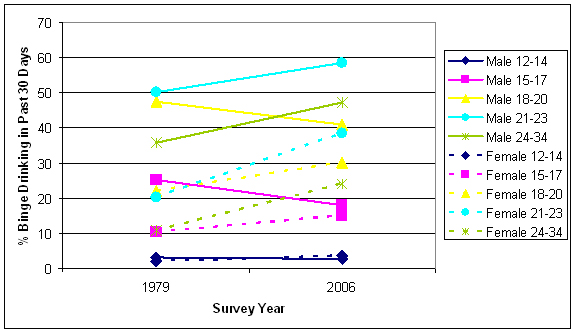Public policy initiatives, such as zero tolerance laws and raising the minimum legal drinking age (MLDA) to 21 years old (circa 1985), have likely contributed to the reduction in alcohol-related traffic fatalities among youth and young adult populations seen in the past two decades. However, it is not clear that the reduction in fatalities corresponds to change in binge drinking among young people. In this DRAM issue, we review Grucza and colleagues’ evaluation of 30 years of data from the National Survey on Drug Use and Health (NSDUH) reflecting patterns of binge drinking (Grucza, Norberg, & Bierut, 2009).
Methodology
- Grucza et al. analyzed data specific to binge drinking behavior (i.e., consuming five or more drinks on one occasion during the past 30 days) from 20 administrations of the NSDUH survey conducted between 1979 and 2006 with more than 500,000 individuals.
- Researchers grouped participant data into four youth categories, 12-14, 15-17, 18-20, and 21-23 years of age; they also created an adult control group 24-34 years old.
- This study combined information from all survey years—except 1982, for which there was no data about binge drinking—into a regression analysis to estimate the influence of gender, age, survey year and their interactions on binge drinking.
Results
- Binge drinking prevalence decreased over time for males under 21, but increased for males over 21 and all female age groups (see Figure).
- Results of the regression indicated that:
-
- All male age groups experienced a significant decrease in relative risk (compared to the 24-34 male age group) for binge drinking across time, ORs range from 0.96 (95% CI: 0.96-0.97; p < .001) to 0.99 (95% CI: 0.98-1.00; p < .05).
- Females age 21-23 experienced a significant increase in relative risk (compared to the 24-34 female age group) for binge drinking across time, OR = 1.02 (95% CI: 1.01-1.03; p < .001).
Figure. Binge drinking prevalence (percentages) by age and gender (adapted from Grucza et al., 2009). Click image to enlarge.
Limitations
- Data were derived from self-report during in-person interviews
- There were multiple survey design changes during the 30 years of this project, potentially making it difficult to compare data over time.
Conclusions
Though the increase of the MLDA to 21 might partially be responsible for the overall reduction in binge drinking behavior among males under 21, this analysis of the NSDUH data suggests that female participants have not responded similarly and that binge drinking among both genders has increased among older youth. It is possible that young women, attempting to close the gender gap, have ignored the messages in these initiatives, a point that the authors highlight. Future research needs to investigate the reasons why certain groups (e.g., women and older youth) fail to benefit from the initiatives already in place, and explore new ways to influence binge drinking behavior within these groups.
What do you think? Please use the comment link below to provide feedback on this article.
References
Grucza, R. A., Norberg, K. E., & Bierut, L. J. (2009). Binge drinking among youths and young adults in the United States: 1979-2006. Journal of the American Academy of Child Adolescent Psychiatry, 48(7), 692-702.





